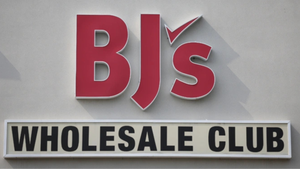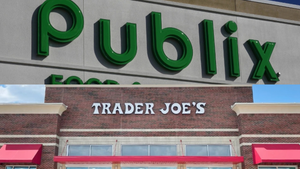BUTTING OUTBUTTING OUT
Security issues, high prices and inconsistent merchandising are preventing some supermarkets from fully realizing sales of recent over-the-counter switches designed to help people stop smoking.At the moment, supermarket sales of these products are lagging behind sales at alternative formats, especially drug stores.According to sales figures from Chicago-based Information Resources Inc., food stores
November 4, 1996
PETER MALBIN
Security issues, high prices and inconsistent merchandising are preventing some supermarkets from fully realizing sales of recent over-the-counter switches designed to help people stop smoking.
At the moment, supermarket sales of these products are lagging behind sales at alternative formats, especially drug stores.
According to sales figures from Chicago-based Information Resources Inc., food stores have 12% of the smoking-cessation market, mass merchandisers have 20% of the pie and drug stores have reaped 68% of the market. These percentages reflect sales through Aug. 11, 1996.
"We think there is potential to do a lot more with anti-smoking products at supermarkets," said David Spohr, category manager at Fleming GMD, a division of Fleming Cos., Oklahoma City. "We're just scratching the surface now. It will be a growing category for us in the next 12 or 16 months."
The future entry of another patch from Ciba Self Medication Inc., Summit, N.J., a wholly owned subsidiary of Ciba Geigy Corp., a subsidiary of Ciba Geigy Ltd., will further expand the category. The company filed an application with the Food and Drug Administration, Rockville, Md., earlier this year to take Habitrol over the counter, according to a spokesman.
Drug stores have embraced the launch of these products and have made them easily accessible, Spohr said. "They have made a big deal about the fact they are now available OTC."
"The drug store setting benefits these products," commented Pete Gassenberger, director of pharmacy and health and beauty care at Consumers Food & Drug, Springfield, Mo. "A large percentage of the population looking for certain [drug] items is still not used to going into a grocery store."
Nicorette, Nicotrol and NicoDerm are the three heavily advertised and touted smoking-cessation products now available over the counter. "Once again, it is SmithKline vs. McNeil," Fleming's Spohr noted. "They had it out before with Tagamet vs. Pepcid."
SmithKline Beecham, Pittsburgh, fired the first shot in the anti-smoking war, launching Nicorette gum OTC in February. It had been prescription-only since 1984.
McNeil Consumer Products Co., Fort Washington, Pa., an affiliate of Johnson & Johnson, released the first OTC nicotine patch, Nicotrol, in July, and SmithKline's own patch, NicoDerm CQ, came out in August. Nicotine patches had been prescription-only since 1991.
Total dollar sales of anti-smoking products amounted to $92.7 million at all three categories of retailers for the 52-week period ended Aug. 11. This figure reflects OTC sales for Nicorette and Nicotrol only. Nicotrol had only been OTC for one month at this point.
At the current rate of sales, smoking-cessation products will generate $600 million annually, said SmithKline Beecham's chief executive officer, Jan Leschly. He was speaking at a Bears Stearns annual health care conference in New York Sept. 12. Leschly said Nicorette gum is generating $6 million in sales every week, NicoDerm is generating sales of about $3 million, and Nicotrol is earning about $2.4 million a week.
"We are showing significant sales with food stores, especially food combo stores," said Clark Brown, senior category promotion manager, SmithKline Beecham Consumer Healthcare division.
"Our product [Nicotrol] is doing well in all markets," said Ron Schmid, vice president of public relations at McNeil Consumer Products, Fort Washington, Pa.
"They have gotten off to a really good start," said Christina Heuer, an analyst at Smith Barney in New York, speaking about the smoking-cessation category in general. "There's been a lot of advertising, but the question is 'Can they repeat their sales?' " She said sales of smoking-cessation products had been "very disappointing" when they were available by prescription-only. "It is very difficult to quit smoking."
Many consumers apparently are willing to at least try to quit smoking, and supermarkets and other retailers selling smoking-cessation products may be the beneficiaries of an increasingly anti-smoking mood in the country. President Clinton has made smoking a political issue, and FDA has new rules that restrict tobacco ads, billboards and promotions that are deemed accessible to minors.
Wholesalers and retailers surveyed by SN are cautiously optimistic about the burgeoning category of anti-smoking products.
"This is a new category," said Steve Lauder, health care category manager at Supervalu, the Minneapolis-based wholesaler. "It's too early to declare it a success or a failure. It's not the hottest item in the world, but we are pleased with sales. Some of our more progressive retailers are taking steps that we find encouraging."
"The category shows promise," said Bill Marth, director of pharmacy at Price Chopper Supermarkets, Schenectady, N.Y. "It has done fairly well in the stores where we have displayed it properly."
"We carry anti-smoking products and we have noticed an increased demand for the products in the past year," said Jenny Enochson, media relations coordinator for Albertson's, Boise, Idaho.
"They are selling better now than they did on prescription. Advertising is helping," said Gassenberger. Consumers Food & Drug will advertise the products in its weekly roto ads and place full-color ads in newspapers. "Our newspaper does a 'medical facts' magazine four times a year, and that's a good vehicle."
Although supermarket pharmacies will be losing a prescription sale in anti-smoking, they will be gaining an over-the-counter sale. "Long-term, with the anti-smoking campaign that is going on, it will be more profitable than prescription," Gassenberger said.
Margins on anti-smoking products are about 15% at Consumers, Gassenberger said, below average for HBC. "But the cost is quite high. When you get a high-dollar item, you have to cut your margins to sell it."
"These are decent margins, they provide very good returns because of the dollar amount. We find them acceptable," said Marth at Price Chopper.
Smoking-cessation products retail between $25 and $50 and come in varying stockkeeping units. Treatments often require repeat purchases or refills.
"If you smoke a pack a day, that's $2 a day. If you want to quit, you are exchanging the cost of one product for another. And long-term you are saving," Gassenberger said. But about half of prospective customers walk away from anti-smoking products because of their high prices, he added. "Most people can spend $2 but they cannot spend $30 all at one time."
These high-ticket items have naturally caused supermarkets to worry about pilferage. "Theft is a concern for us,"said Enochson at Albertson's. "Depending on the layout of the store, we are trying three different techniques to control it. We have locked products up in a display case, we have done dummy displays, and we have placed them immediately in front of the pharmacy counter where they are watched at all times."
All three techniques have helped, Enochson said. "They have all been successful."
Manufacturers have created a category rack system and are providing supermarkets with lockable freestanding kiosks, sidekicks and in-line shelving units.
"Supermarkets should consider where they can merchandise the racks to take advantage of the category," said SmithKline's Brown. "Proper merchandising, as well as the use of the rack system, is our effort in helping the retailer manage shrink. We have tried to create a 'home' for this category."
Other supermarkets have tried different merchandising approaches to the category. Baker's Supermarkets, Omaha, Neb., for example, secures smoking-cessation products behind the counter of pharmacies, or under lock and key.
At Consumers Food & Drug, the products are kept behind the pharmacy counter. "Behind the counter inhibits sales," Gassenberger admits. "We will be getting lockable display cases soon from a broker and will put it in front of the pharmacy. The health and beauty aids people will have keys for night time."
At Price Chopper, the products are openly displayed on a floor-stand unit, adjacent to the pharmacy, and during the hours the pharmacy is open the display unit is unlocked. "They are right there with the pharmacist in an attended area where there are usually people milling around waiting for prescriptions," Marth said. "This is not a product you'll see just openly left on a shelf."
Other supermarkets, such as a Shop Rite in Jersey City, N.J., are keeping anti-smoking products in locked "cages" with their nemesis -- cigarettes -- at courtesy stations. They were originally sold at Shop Rite's pharmacies, said Paresh Patel, a pharmacist at Shop Rite Pharmacy, Jersey City, but no longer. "I don't have time to open a cage," he said.
"I don't want them sold near me," Patel said. "They're listed as a tobacco product. You have to ID everyone 18 or older. One of the pharmacists in New Jersey was warned for selling one of the products to a minor." Shop Rite has ordered locked display cases for the products, Patel said.
"We wouldn't sell it with cigarettes," said a vice president of general merchandise/health and beauty care/pharmacy for a leading California supermarket chain. Anti-smoking products sell better when they are self-service with other HBC items, he said. "The ideal location should be close to the pharmacy."
"I think the supermarket merchandisers have to make a decision about how aggressively they want to be in this market," commented Bill Bishop, a retail consultant at Willard Bishop Consulting, Barrington, Ill.
A director of nonfood at a 12-store southern California chain, who asked to remain unidentified, said his stores are carrying the gum on a test basis.
"Right now, we are carrying two stockkeeping units on the shelves in dummy boxes and that's it," he said.
"Our space is limited. It is not doing that well for us. We are working with SmithKline to possibly bring in the patch. I'd like to give it at least three months' time. It's a high-ticket item that we will have to learn to accept.
When you don't have a lot of space, you have to see whether you are going to get the turns on it to warrant the space. And so far turns have been soft. But we have to be open enough to pursue it, to see if our customers have the need to buy it in a food store," the director added.
Smoldering Sales
Smoking-cessation products, which previously were available by prescription only, emerged this year as a new category on supermarket shelves. However, the charge to sell these products has been led by the drug channel, which captured 68% of the emerging market. Mass merchandisers were second, racking up 19.5% of the market share. Supermarkets lagged behind with a 12.5% share of the market for the 52-week period ended Aug. 11, according to Information Resources.
The next entry into the category will most likely be Habitrol patch therapy. Ciba Self Medication, the manufacturer, has filed an OTC application with the FDA. Approval could come next year.
Prescription and OTC Sales of Smoking-Cessation Drugs
RX $ Sales $Sales OTC
in millions RX Share RX % /- in millions Share
NicoDerm
(SmithKline
Beecham) $91.35 41.2% 7% -- --
Habitrol
(Ciba Self
Medication) $54.6 424.6% -21% -- --
Nicorette
(SmithKline
Beecham) $54.48 24.1% 4% $89 96%
Nicotrol
(McNeil
Consumer
Products) $15.2 56.9% -10% $3.1 4%
ProStep
(American
Home
Products) $7.18 3.2% -32% -- --
Total Market $221.91 100% -5% $12 100%
Sources: *IMS America, Totowa, N.J., for calendar year ending December 31, 1995; **Information Resources, Inc., Chicago., for 52-week period ending August 11, 1996.
About the Author
You May Also Like




